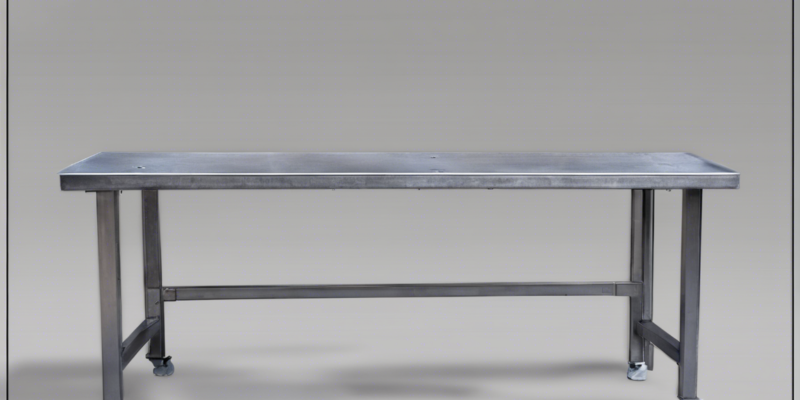Steel tables are essential tools in engineering, construction, and other industries where precise measurements and sturdy support are required. From standard sizing to specialized designs, steel tables come in various shapes and sizes to meet a wide range of needs. In this comprehensive guide, we will explore the different types of steel tables available, their uses, benefits, and provide a detailed overview on how to choose the right steel table for your specific requirements.
Types of Steel Tables
When it comes to steel tables, there are several types available on the market, each designed for different purposes. Some common types of steel tables include:
1. Workbenches: Workbenches are sturdy tables used for various tasks, such as woodworking, metalworking, and general maintenance. They typically feature a flat surface and may come with additional storage options like drawers or shelves.
2. Welding Tables: Welding tables are specifically designed to withstand the heat and spatter generated during welding processes. They are made of heat-resistant materials and often feature clamps or fixtures to hold the workpiece securely in place.
3. Drafting Tables: Drafting tables are equipped with a tilting mechanism that allows users to adjust the working surface to a comfortable angle for drawing, drafting, or other artistic endeavors. They are commonly used by architects, engineers, and artists.
4. Outdoor Tables: Outdoor steel tables are designed to withstand the elements and are often used for dining or recreational purposes in outdoor settings like patios, gardens, or parks. They are typically coated or treated to prevent rust and corrosion.
5. Utility Tables: Utility tables are versatile tables used in various settings, including offices, workshops, and laboratories. They can serve as multipurpose work surfaces, assembly tables, or equipment stands.
Benefits of Steel Tables
Steel tables offer numerous benefits compared to tables made from other materials. Some of the key advantages of steel tables include:
1. Durability: Steel is known for its strength and durability, making it ideal for heavy-duty applications. Steel tables can withstand heavy loads and are resistant to dents, scratches, and corrosion.
2. Stability: Steel tables provide a stable and sturdy work surface, ensuring that your workpiece remains secure during tasks like cutting, welding, or assembly.
3. Easy Maintenance: Steel tables are easy to clean and maintain, requiring minimal upkeep to retain their appearance and functionality.
4. Customization: Steel tables can be customized to meet specific requirements, including size, shape, surface finish, and additional features like drawers, shelves, or casters.
How to Choose the Right Steel Table
When selecting a steel table for your needs, consider the following factors to ensure you get the right table for the job:
1. Purpose: Determine the primary use of the table, whether it is for woodworking, welding, drafting, or general work tasks.
2. Size and Capacity: Consider the dimensions of the table, including length, width, and height, as well as the weight capacity to support your work requirements.
3. Material: Choose the appropriate grade of steel based on the intended use and environmental conditions. Common steel grades include mild steel, stainless steel, and galvanized steel.
4. Features: Select any additional features you may need, such as drawers, shelves, adjustable height, tilting surface, or mobility options like casters.
5. Budget: Establish a budget for the steel table purchase and explore various options that fit within your price range while meeting your requirements.
Maintenance Tips for Steel Tables
To ensure the longevity and performance of your steel table, follow these maintenance tips:
1. Regular Cleaning: Wipe down the steel table surface regularly with a damp cloth to remove dust, dirt, or debris. Use a mild detergent or metal cleaner for tough stains.
2. Rust Prevention: Apply a rust-resistant coating or paint to prevent corrosion on the steel surface, especially for outdoor or high-moisture environments.
3. Avoid Sharp Objects: Minimize the risk of scratches or dents by avoiding sharp or abrasive objects on the steel table surface.
4. Lubrication: Periodically lubricate any moving parts, such as hinges or drawers, to ensure smooth operation and prevent rust.
5. Inspection: Regularly inspect the table for any signs of damage, such as dents, cracks, or loose fasteners, and address any issues promptly.
Frequently Asked Questions (FAQs)
Q: Are steel tables suitable for outdoor use?
A: Yes, steel tables can be used outdoors, but it is essential to choose a table that is specifically designed for outdoor use and is treated for rust and corrosion resistance.
Q: Can steel tables be customized to specific dimensions?
A: Yes, many manufacturers offer customization options for steel tables, allowing customers to specify the dimensions, features, and finishes according to their requirements.
Q: What is the weight capacity of a typical steel table?
A: The weight capacity of a steel table can vary depending on its size, design, and construction. It is advisable to check the manufacturer’s specifications for the specific table you are considering.
Q: How do I assemble a steel table?
A: Most steel tables come with assembly instructions and necessary hardware. Follow the provided guidelines carefully to assemble the table correctly and securely.
Q: Can I repaint a steel table if the paint wears off?
A: Yes, you can repaint a steel table to refresh its appearance or provide additional protection against rust. Ensure proper surface preparation and use a suitable paint for metal surfaces.
In conclusion, steel tables are versatile and durable furniture pieces that find applications in various industries and settings. By understanding the different types of steel tables, their benefits, factors to consider when choosing one, and essential maintenance tips, you can select the right steel table to meet your specific needs and ensure its longevity and performance.


Comments